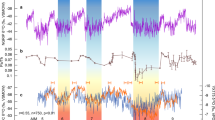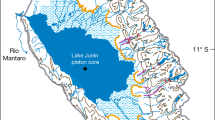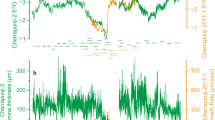Abstract
The tropics are the main source of the atmosphere's sensible and latent heat, and water vapour, and are therefore important for reconstructions of past climate1. But long, accurately dated records of southern tropical palaeoclimate, which would allow the establishment of climatic connections to distant regions, have not been available. Here we present a 210,000-year (210-kyr) record of wet periods in tropical northeastern Brazil—a region that is currently semi-arid. The record is obtained from speleothems and travertine deposits that are accurately dated using the U/Th method. We find wet periods that are synchronous with periods of weak East Asian summer monsoons2, cold periods in Greenland3, Heinrich events in the North Atlantic4 and periods of decreased river runoff to the Cariaco basin5. We infer that the wet periods may be explained with a southward displacement of the Intertropical Convergence Zone. This widespread synchroneity of climate anomalies suggests a relatively rapid global reorganization of the ocean–atmosphere system. We conclude that the wet periods probably affected rainforest distribution, as plant fossils show that forest expansion occurred during these intermittent wet intervals, and opened a forest corridor6,7,8 between the Amazonian and Atlantic rainforests.
This is a preview of subscription content, access via your institution
Access options
Subscribe to this journal
Receive 51 print issues and online access
$199.00 per year
only $3.90 per issue
Buy this article
- Purchase on Springer Link
- Instant access to full article PDF
Prices may be subject to local taxes which are calculated during checkout



Similar content being viewed by others
References
Hastenrath, S. Climate Dynamics of the Tropics 302–309 (Kluwer Academic, Dordrecht, 1991)
Wang, Y. J. et al. A high-resolution absolute-dated Late Pleistocene monsoon record from Hulu Cave, China. Science 294, 2345–2348 (2001)
Grootes, P. M. & Stuiver, M. Oxygen 18/16 variability in Greenland snow and ice with 103 to 105-year time resolution. J. Geophys. Res. 102, 26455–26470 (1997)
Bond, G. et al. Correlations between climate records from North Atlantic sediment and Greenland ice. Nature 365, 143–147 (1993)
Peterson, L. C., Haug, G. H., Hughen, K. A. & Rohl, U. Rapid changes in the hydrologic cycle of the Tropical Atlantic during the last glacial. Science 290, 1947–1951 (2000)
Por, F. D. Sooretama: The Atlantic Rain Forest of Brazil 130 (SPB Academic, The Hague, 1992)
De Oliveira, P. E., Barreto, A. M. F. & Suguio, K. Late Pleistocene/Holocene climatic and vegetational history of the Brazilian caatinga: The fossil dunes of the middle Sao Francisco River. Paleogeogr. Paleoclimatol. Paleoecol. 152, 319–337 (1999)
Behling, H., Arz, H. W., Patzold, J. & Wefer, G. Late Quaternary vegetational and climate dynamics in northeastern Brazil, inferences from marine core GeoB 3104–1. Quat. Sci. Rev. 19, 981–994 (2000)
Ayliffe, L. K. et al. 500 ka precipitation record from southeastern Australia: Evidence for interglacial relative aridity. Geology 26, 147–150 (1998)
Auler, A. S. & Smart, P. L. Late Quaternary paleoclimate in semiarid northeastern Brazil from U-series dating of travertine and water-table speleothems. Quat. Res. 55, 159–167 (2001)
Arz, H. W., Patzold, J. & Wefer, G. Correlated millennial-scale changes in surface hydrography and terrigenous sediment yield inferred from Last-Glacial marine deposits off northeastern Brazil. Quat. Res. 50, 157–166 (1998)
Edwards, R. L., Chen, J. H. & Wasserburg, G. J. 238U-234U-230Th-232Th systematics and the precise measurement of time over the past 500,000 years. Earth Planet. Sci. Lett. 81, 175–192 (1986)
Shen, C.-C. et al. Uranium and thorium isotopic and concentration measurements by magnetic sector inductively coupled plasma mass spectrometry. Chem. Geol. 185, 165–178 (2002)
Yuan, D. X. et al. Timing, duration, and transition of the Last Interglacial Asian Monsoon. Science 304, 575–578 (2004)
McManus, J. F., Anderson, R. F., Broecker, W. S., Fleisher, M. Q. & Higgins, S. M. Radiometrically determined sedimentary fluxes in the sub-polar North Atlantic during the last 140,000 years. Earth Planet. Sci. Lett. 155, 29–43 (1998)
Bard, E., Antonioli, F. & Silenzi, S. Sea-level during the penultimate interglacial period based on a submerged stalagmite from Argentarola Cave (Italy). Earth Planet. Sci. Lett. 196, 135–146 (2002)
Gadgil, S. The Indian Monsoon and its variability. Annu. Rev. Earth Planet. Sci. 31, 429–467 (2003)
Chang, P., Ji, L. & Li, H. A decadal climate variation in the tropical Atlantic ocean from thermodynamic air-sea interactions. Nature 385, 516–518 (1997)
Moura, A. D. & Shukla, J. On the dynamics of droughts in Northeast Brazil: Observations, theory and numerical experiments with a General Circulation Model. J. Atmos. Sci. 38, 2653–2675 (1981)
Nobre, P. & Shukla, J. Variations of sea surface temperature, wind stress, and rainfall over the tropical Atlantic and South America. J. Clim. 9, 2464–2479 (1996)
Chiang, J. C. H., Biasutti, M. & Battisti, D. S. Sensitivity of the Atlantic ITCZ to last glacial maximum boundary conditions. Paleoceanography 18, 1094, doi:10.1029/2003PA000916 (2003)
Broecker, W. S. Paleocean circulation during the last deglaciation: a bipolar seesaw? Paleoceanography 13, 119–121 (1998)
Lydolph, P. E. The Climate of the Earth 103–114 (Rowman & Allanheld, Totowa, 1985)
Clement, A. C., Hall, A. & Broccoli, A. J. The importance of precessional signals in the tropical climate. Clim. Dyn. 22, 327–341 (2004)
Baker, P. A. et al. Tropical climate changes at millennial and orbital timescales on the Bolivian Altiplano. Nature 409, 698–701 (2001)
Haffer, J. in Biological Diversification in the Tropics (ed. Prance, G. T.) 6–24 (Columbia Univ. Press, New York, 1982)
Colinvaux, P. A., De Oliveira, P. E. & Bush, M. B. Amazonian and neotropical plant communities on glacial time-scales: The failure of the aridity and refuge hypotheses. Quat. Sci. Rev. 19, 141–169 (2000)
Costa, L. P. The historical bridge between the Amazon and the Atlantic forest of Brazil: a study of molecular phylogeography with small mammals. J. Biogeogr. 30, 71–86 (2003)
Meese, D. A. et al. The Greenland Ice Sheet Project 2 depth-age scale: Methods and results. J. Geophys. Res. 102, 26411–26423 (1997)
Berger, A. & Loutre, M. F. Insolation values for the climate of the last 19 million years. Quat. Sci. Rev. 10, 297–317 (1991)
Acknowledgements
We thank G. Comer and W. Broecker for their support of our work. We acknowledge the help of many friends from Grupo Bambuí de Pesquisas Espeleológicas who participated in the field trips, sampling and geological observations. Cave sampling was performed with permission from IBAMA/CECAV; we are grateful for the collaboration of land owners and local people. This work was supported by the NSF, the Gary Comer Science & Education Foundation and the CNPq of Brazil.
Author information
Authors and Affiliations
Corresponding author
Ethics declarations
Competing interests
The authors declare that they have no competing financial interests.
Supplementary information
Supplementary Table 1
Uranium and thorium isotopic compositions and 230Th ages for northeastern Brazil speleothems. (PDF 105 kb)
Supplementary Table 2
Uranium and thorium isotopic compositions and 230Th ages for northeastern Brazil travertines. (PDF 93 kb)
Supplementary Figure 1
Plot of measured δ234U versus 230Th/238U activity ratio of northeastern Brazil travertine samples. (PDF 27 kb)
Supplementary Figure 2
Stalagmite TBV-40 with ages and depths (collected from Toca da Boa Vista cave). (PDF 104 kb)
Supplementary Figure 3
Young travertine deposits from the Salitre river valley. (PDF 124 kb)
Rights and permissions
About this article
Cite this article
Wang, X., Auler, A., Edwards, R. et al. Wet periods in northeastern Brazil over the past 210 kyr linked to distant climate anomalies. Nature 432, 740–743 (2004). https://doi.org/10.1038/nature03067
Received:
Accepted:
Issue Date:
DOI: https://doi.org/10.1038/nature03067
This article is cited by
-
Growth rates of Brazilian carbonate speleothems by the 210Pb chronological method
Environmental Earth Sciences (2024)
-
Summer insolation controlled movements of Intertropical Convergence Zone during last glacial cycle in northern South America
Communications Earth & Environment (2023)
-
Identifying the mechanisms of DO-scale oscillations in a GCM: a salt oscillator triggered by the Laurentide ice sheet
Climate Dynamics (2023)
-
Model-Based Analyses Suggest Pleistocene Refugia over Ancient Divergence as Main Diversification Driver for a Neotropical Open-Habitat Treefrog
Evolutionary Biology (2023)
-
The response of the hydrological cycle to temperature changes in recent and distant climatic history
Progress in Earth and Planetary Science (2022)
Comments
By submitting a comment you agree to abide by our Terms and Community Guidelines. If you find something abusive or that does not comply with our terms or guidelines please flag it as inappropriate.



